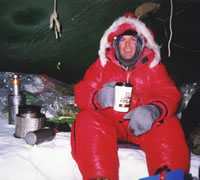The key to enjoying a cold-weather wilderness
trip is staying warm. And the easiest way to do this is by
imitating an onion, or dressing in layers. The ability to
add or remove layers will allow you to remain comfortable
whether you're stargazing on a 20-below night or pulling a
100-pound sledge with snowshoes. An effective layering system
consists of three layers: an inner wicking layer, one or more
middle insulating layers, and an outer wind shell.
The innermost layer must wick perspiration
from the skin and transport it to an adjacent, outer layer.
For this to occur, the wicking layer must be very thin and
in direct contact with the skin.
Synthetic fibers work best since natural
fibers, such as cotton, wool, and silk, tend to absorb or
hold on to moisture instead of transporting or moving it.
Look for underwear tops and bottoms, face
masks, liner socks, and liner gloves made from polypropylene,
Capilene, Coolmax, Dryskin, Powerdry, Thermastat, and Thermax.
The middle, insulating layer traps air
and restricts its circulation. This layer keeps you warm.
Remember, several thin garments are warmer and more flexible
than a single thick layer.
Each garment should be large enough so,
in the worst of conditions, they can all be worn together.
Pants with full-length, separating leg zippers can be easily
added or removed while wearing boots, snowshoes, or skis.
Since cotton and down are very poor insulators
when wet, look for pants, shirts, sweaters, jackets, vests,
socks, hats, and mittens made from wool; piles and fleeces
such as Berber Pile, Borg Pile, Synchilla, and Polartec; and
fiber fills such as Hollofil, Lamilite, Lite Loft, Microloft,
Polarguard, Primaloft, Quallofil, Thermoloft, Thermolite,
and Thinsulate.
The outer shell layer protects you from
the wind, rain, and snow. For the upper body, a parka with
a hood as well as wrist and waist closures is best. Pants
with waist and ankle closures work well to protect the lower
body.
Both of these garments should be sufficiently
oversized so they'll fit over all of the insulating layers
when they're worn at once in extremely cold weather.
Breathable, windproof shell garments are
often constructed of Ripstop, Supplex, Taslan, Versatech,
etc. Waterproof and breathable shells are typically made from
Gore-Tex, the industry standard, or Avalite, Entrant, Extreme,
Hely-Tech, Ultrex, etc.
Always carry a thin polypropylene balaclava
(or face mask) as well as two warm hats as you can loose from
50 to 70 percent of your body heat through an uncovered head.
While the head is the body's regulator,
the arms and legs are the body's radiators. When your core
temperature heats up, the body increases circulation to the
arms and legs (read: warm hands and feet).
Similarly, when your core temperature
cools down, the body conserves vital heat by reducing circulation
to the arms and legs (read: cold hands and feet). So, if you
want warm hands and feet, keep your torso and head warm.
To keep from loosing what little heat reaches
your hands, use a layered mitten system consisting of polypro
glove liners, one or two insulating mittens, and mitten shells.
To keep your feet warm, wear one or two
pairs of thick insulating socks over a pair of polypro liner
socks. Boots with thick, removable felt liners and one or
two insoles are a good choice in cold weather.
No matter what type of footwear you use,
make sure they don't fit too tight. If your feet lack wiggle
room, remove a pair of socks. Adequate circulation is essential
as tight footwear means cold feet.
For this system to work, it's imperative
that each piece of clothing be sufficiently large so that
every item can be worn at once, in any order, in the worst
of conditions.
When you're active, wear only those layers
needed to stay comfortable. As you cool down, add a layer.
If you feel yourself heating up, simply remove a layer before
you start to sweat.
Regularly drinking water and snacking on
high-energy foods will also help keep you warm as well as
stave off dehydration and hypothermia.
By carefully assembling a layering system
and learning how to use it properly, your next cold-weather
outing will be much more enjoyable, not to mention safer.
To learn more about how to stay warm in
the wilderness, read The Outward Bound Staying Warm
in the Outdoors Handbook, by Glenn Randall (The Lyons
Press, 2000) or Secrets of Warmth--for Comfort or Survival,
by Hal Weiss (Mountaineers Books, 1999).
|
|
|
|


